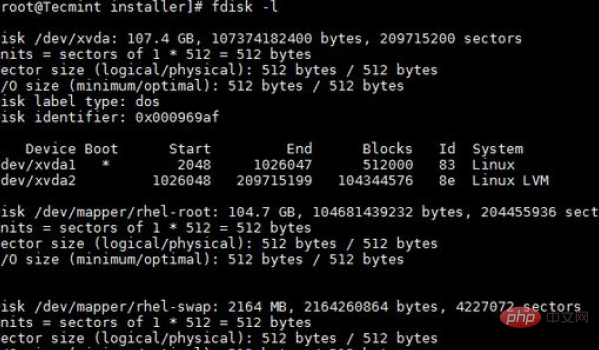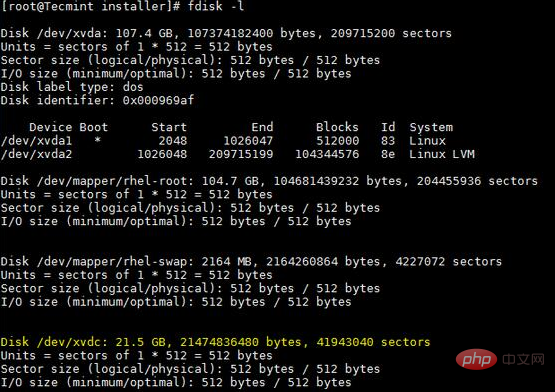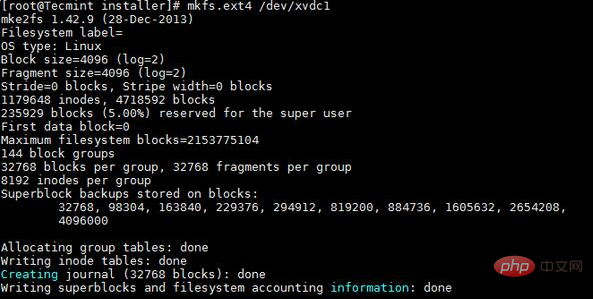How to add a hard disk in linux
How to add a hard disk in Linux: 1. Use the fdisk command to display the current hard disk partition status, and press the "n" key to add a new partition; 2. Use the mkfs command to format the partition; 3. Use the mount command to mount the partition. ;4. Use the "defaults 0 0" statement to set automatic mounting at permanent startup.

#The operating environment of this tutorial: linux7.3 system, Dell G3 computer.
How to add a hard disk in Linux
A hard disk with a capacity of 20GB has been added and mounted to the /data partition.
fdisk is a command line tool used to display and manage hard disks and partitions on Linux systems.
# fdisk -l
This command will list the current partition and configuration.

After adding a 20GB hard drive, the output of fdisk -l is as follows.
# fdisk -l

View new partition details
The newly added disk is displayed as /dev/xvdc. If we were adding a physical disk, it would look like /dev/sda based on the disk type. Here I am using a virtual disk.
To partition on a specific hard drive, such as /dev/xvdc.
# fdisk /dev/xvdc
Commonly used fdisk commands
n - Create partition
p - Print partition table
d - Delete a partition
q -Exit without saving changes
w -Save changes and exit
Since we want to create a partition, use the n option.

Create a primary partition or extended partition. By default we can have up to 4 primary partitions.
Enter the partition number as required. It is recommended to use the default value of 1.
Enter the size of the first sector. If it is a new disk, usually choose the default value. If you are creating a second partition on the same disk, we need to add 1 to the last sector of the previous partition.
Enter the value of the last sector or partition size. It is generally recommended to enter the size of the partition. Always add prefix to prevent value out of range errors.
Save changes and exit.
How to add a new disk on a Linux system How to add a new disk on a Linux system
Save partition changes
Now use the mkfs command to format the disk.
# mkfs.ext4 /dev/xvdc1

Format the new partition
After the formatting is completed, follow the following command to mount the partition.
# mount /dev/xvdc1 /data
Add entries in the /etc/fstab file for automatic mounting on permanent boot.
/dev/xvdc1 /data ext4 defaults 0 0
Related recommendations: "Linux Video Tutorial"
The above is the detailed content of How to add a hard disk in linux. For more information, please follow other related articles on the PHP Chinese website!

Hot AI Tools

Undresser.AI Undress
AI-powered app for creating realistic nude photos

AI Clothes Remover
Online AI tool for removing clothes from photos.

Undress AI Tool
Undress images for free

Clothoff.io
AI clothes remover

Video Face Swap
Swap faces in any video effortlessly with our completely free AI face swap tool!

Hot Article

Hot Tools

Notepad++7.3.1
Easy-to-use and free code editor

SublimeText3 Chinese version
Chinese version, very easy to use

Zend Studio 13.0.1
Powerful PHP integrated development environment

Dreamweaver CS6
Visual web development tools

SublimeText3 Mac version
God-level code editing software (SublimeText3)

Hot Topics
 What computer configuration is required for vscode
Apr 15, 2025 pm 09:48 PM
What computer configuration is required for vscode
Apr 15, 2025 pm 09:48 PM
VS Code system requirements: Operating system: Windows 10 and above, macOS 10.12 and above, Linux distribution processor: minimum 1.6 GHz, recommended 2.0 GHz and above memory: minimum 512 MB, recommended 4 GB and above storage space: minimum 250 MB, recommended 1 GB and above other requirements: stable network connection, Xorg/Wayland (Linux)
 Linux Architecture: Unveiling the 5 Basic Components
Apr 20, 2025 am 12:04 AM
Linux Architecture: Unveiling the 5 Basic Components
Apr 20, 2025 am 12:04 AM
The five basic components of the Linux system are: 1. Kernel, 2. System library, 3. System utilities, 4. Graphical user interface, 5. Applications. The kernel manages hardware resources, the system library provides precompiled functions, system utilities are used for system management, the GUI provides visual interaction, and applications use these components to implement functions.
 vscode terminal usage tutorial
Apr 15, 2025 pm 10:09 PM
vscode terminal usage tutorial
Apr 15, 2025 pm 10:09 PM
vscode built-in terminal is a development tool that allows running commands and scripts within the editor to simplify the development process. How to use vscode terminal: Open the terminal with the shortcut key (Ctrl/Cmd). Enter a command or run the script. Use hotkeys (such as Ctrl L to clear the terminal). Change the working directory (such as the cd command). Advanced features include debug mode, automatic code snippet completion, and interactive command history.
 How to check the warehouse address of git
Apr 17, 2025 pm 01:54 PM
How to check the warehouse address of git
Apr 17, 2025 pm 01:54 PM
To view the Git repository address, perform the following steps: 1. Open the command line and navigate to the repository directory; 2. Run the "git remote -v" command; 3. View the repository name in the output and its corresponding address.
 Where to write code in vscode
Apr 15, 2025 pm 09:54 PM
Where to write code in vscode
Apr 15, 2025 pm 09:54 PM
Writing code in Visual Studio Code (VSCode) is simple and easy to use. Just install VSCode, create a project, select a language, create a file, write code, save and run it. The advantages of VSCode include cross-platform, free and open source, powerful features, rich extensions, and lightweight and fast.
 How to run java code in notepad
Apr 16, 2025 pm 07:39 PM
How to run java code in notepad
Apr 16, 2025 pm 07:39 PM
Although Notepad cannot run Java code directly, it can be achieved by using other tools: using the command line compiler (javac) to generate a bytecode file (filename.class). Use the Java interpreter (java) to interpret bytecode, execute the code, and output the result.
 What is the main purpose of Linux?
Apr 16, 2025 am 12:19 AM
What is the main purpose of Linux?
Apr 16, 2025 am 12:19 AM
The main uses of Linux include: 1. Server operating system, 2. Embedded system, 3. Desktop operating system, 4. Development and testing environment. Linux excels in these areas, providing stability, security and efficient development tools.
 How to run sublime after writing the code
Apr 16, 2025 am 08:51 AM
How to run sublime after writing the code
Apr 16, 2025 am 08:51 AM
There are six ways to run code in Sublime: through hotkeys, menus, build systems, command lines, set default build systems, and custom build commands, and run individual files/projects by right-clicking on projects/files. The build system availability depends on the installation of Sublime Text.






